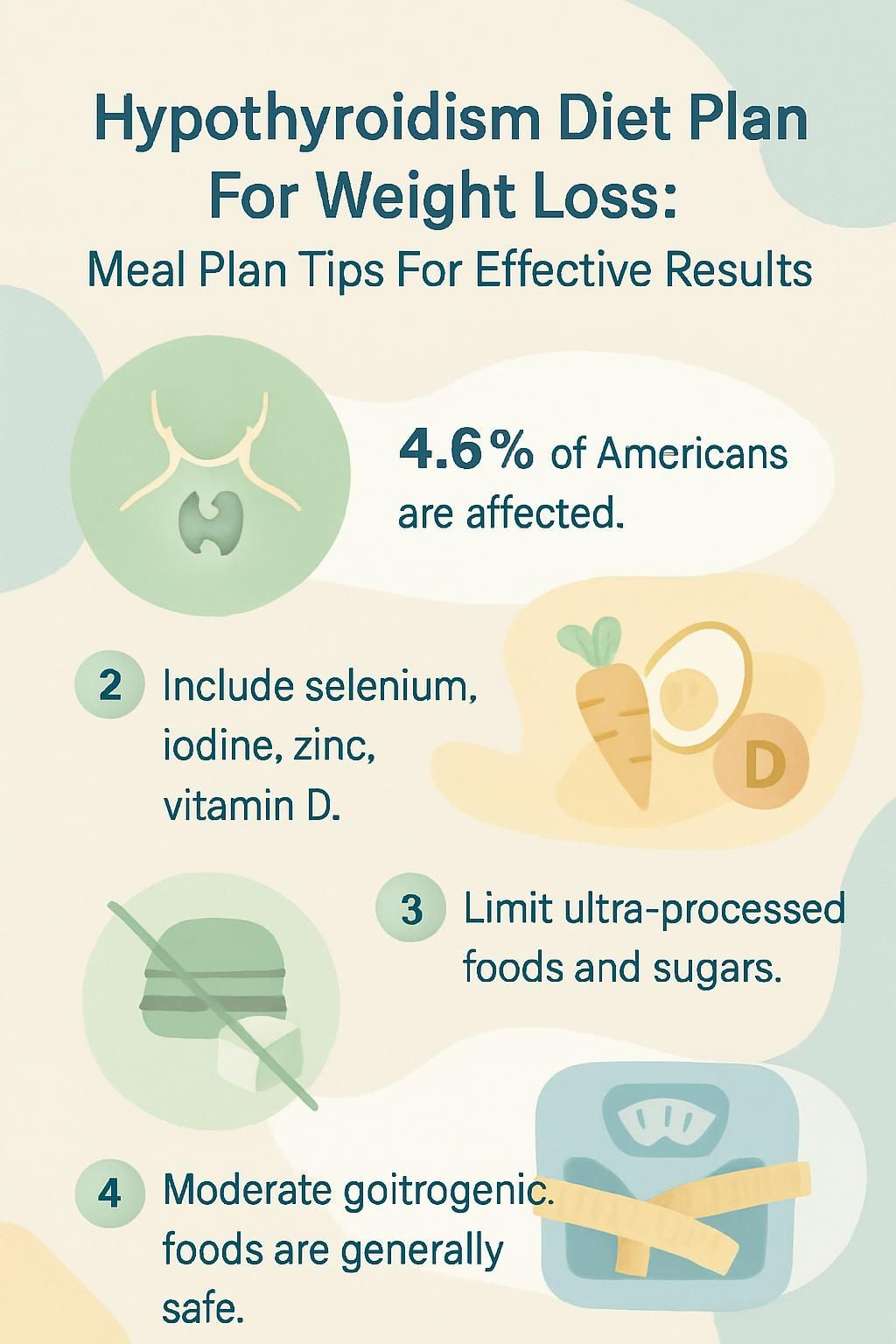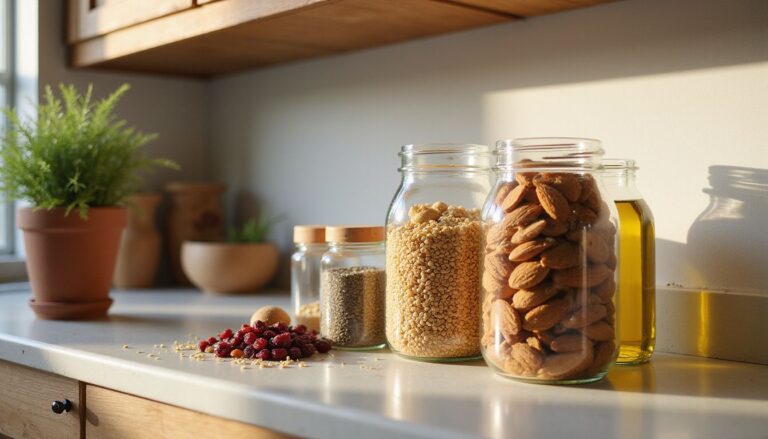Hypothyroidism Diet Plan For Weight Loss: Meal Plan Tips For Effective Results
Our Nutrition Assistant AI Suite will transform your body. You will lose fat, get toned, and build muscle. Gain confidence and optimal health.
If you have gained weight and feel stuck because of an underactive thyroid, you are not alone. Hypothyroidism can slow metabolism, raise fatigue, and make weight control feel harder. A structured hypothyroidism diet can help you take back control with small, steady steps.
This guide on Hypothyroidism Diet Plan For Weight Loss shares practical meal plan tips, foods to eat and avoid, and simple ways to support thyroid function. You will learn how nutrition choices affect hormones, energy, and appetite.
Keep reading to find clear steps that may help you feel better day to day.
Key Takeaways
- Hypothyroidism affects about 4.6% of Americans and often leads to weight gain and fatigue, according to 2023 data.
- A helpful plan includes whole grains, lean proteins, anti-inflammatory foods, and nutrients like selenium, iodine, zinc, and vitamin D.
- Limit ultra-processed foods, sugary drinks, and refined carbs to reduce inflammation and support stable thyroid hormone levels.
- Current 2024 research suggests moderate intake of goitrogenic foods, like broccoli or soy, is safe unless iodine is low or your clinician advises otherwise.
- Take thyroid medication exactly as prescribed. Avoid food and drinks for 30 minutes after dosing, and work with your healthcare provider to personalize your plan.

How Does Hypothyroidism Affect Weight Management?

Hypothyroidism can make weight loss with hypothyroidism more difficult because your body burns fewer calories at rest. When thyroid hormone is low, your metabolism slows and weight can rise even when you eat sensibly.
What is hypothyroidism?
The thyroid gland makes hormones that control growth, cell repair, and energy use. With hypothyroidism, the gland does not produce enough thyroid hormone. This thyroid disorder is often called an underactive thyroid.
Common symptoms of hypothyroidism include weight gain, fatigue, feeling cold, and constipation. Treatment usually includes thyroid hormone replacement, such as levothyroxine. Blood tests confirm low hormone levels and guide the dose.
Autoimmune disease, especially Hashimoto’s thyroiditis, is a frequent cause in adults. Recent surveys suggest about 4.6 percent of people in the United States have low thyroid function.
How does hypothyroidism impact metabolism and body weight?
Low thyroid hormone slows metabolism, so your body burns fewer calories throughout the day. Many people gain weight or find it harder to lose weight, even with a balanced diet and regular exercise.
Untreated hypothyroidism is linked with inflammation and oxidative stress. Both can worsen metabolic health and make weight loss goals harder to reach. Fatigue can also reduce daily movement, which adds another barrier.
Research updated in 2024 suggests higher cardiovascular risk if the condition remains uncontrolled. A diet rich in fiber, antioxidants, and nutrients that support thyroid hormone production can help break this cycle.
Small changes in daily movement can help a lot. During my early days with thyroid disease, even short walks plus a high-fiber diet eased stubborn weight gain.
Small steps like walking after meals or choosing more whole grains often helped me feel more energetic, even on tough days living with hypothyroidism.
Why Is Nutrition Important for Managing Hypothyroidism?
Eating a nutritious diet supports your thyroid gland and may ease symptoms. Key nutrients include selenium, iodine, zinc, iron, vitamin D, and magnesium. These help your body make and use thyroid hormones.
Many people with hypothyroidism have low levels of these nutrients. Correcting gaps can improve energy, mood, and digestion. Timing also matters because certain foods can affect how your thyroid medication is absorbed.
Build meals around whole grains, lean protein like fish or beans, nuts and seeds, and fiber-rich fruits and vegetables. Many people find a Mediterranean-style diet easier to maintain. It supplies helpful fats, antioxidants, and steady energy.
A smart plan limits processed foods and keeps your routine simple. This makes it easier to follow treatment while you work on long-term habits that support thyroid health.
Dietary Strategies to Lose Weight with Hypothyroidism
Targeted diet changes can support weight loss with hypothyroidism. Start with whole, unprocessed foods. Then layer in fiber, hydration, and steady meal timing.
Which whole, unprocessed foods should I choose?
Whole foods provide nutrients without excess sugar, sodium, or additives. They also reduce the chance of interfering with thyroid medication.
- Fruits: berries, apples, pears, grapes, citrus, peaches, pineapple, and bananas. These add fiber and antioxidants.
- Vegetables: spinach, artichokes, zucchini, carrots, mushrooms, asparagus, leafy greens, and peppers. Low in calories, high in vitamins.
- Lean proteins: fish, shellfish, eggs, chicken, and turkey. Protein helps maintain muscle during weight loss.
- Whole grains: brown rice, rolled oats, quinoa, and brown rice pasta. These can ease constipation, which is common with hypothyroidism.
- Beans and lentils: chickpeas and kidney beans for plant protein and fiber.
- Healthy fats: avocados and nuts for cell support. Limit butter and highly processed oils.
- Sources of selenium and iodine: eggs, seafood, dairy if tolerated, and Brazil nuts.
- Fluids: make water your main drink to reduce fatigue and digestive issues.
Choosing these foods can help you build a diet plan for hypothyroidism that supports steady progress.
How can I increase fiber intake effectively?
Fiber supports digestion, helps you feel full, and stabilizes blood sugar. Aim to increase it gradually to avoid bloating.
Start your day with overnight oats made from gluten-free oats, chia seeds, nut butter, and banana. For lunch, try Mediterranean quinoa salad or pumpkin soup. Both provide fiber and helpful nutrients.
Use chickpeas or lentils on salads for an easy boost. Swap processed snacks for carrot sticks, cucumber slices, or a small apple. Batch-cook beans, sweet potatoes, and peas so you have quick options during busy weeks.
These steps work whether you prefer a plant-forward pattern or a mixed diet. The goal is more fiber and fewer refined foods.
Why reduce added sugars and refined carbs?
High sugar foods and refined carbs raise blood sugar quickly. This can worsen inflammation and make appetite swings more likely, which makes weight loss harder.
Common culprits include soda, sweetened cereals, flavored granola bars, and chips. Replacing these with whole foods supports your thyroid diet and helps keep energy stable.
Research shows cutting sugary drinks improves metabolic health and lowers markers of inflammation. Small swaps add up across a week.
What are the best anti-inflammatory ingredients to add?
Inflammation can affect how you feel and how your body uses energy. Anti-inflammatory foods and spices may ease symptoms and support thyroid health.
- Extra virgin olive oil, avocados, and avocado oil provide helpful fats.
- Walnuts, almonds, and pumpkin seeds supply minerals and plant fats.
- Turmeric, saffron, and basil can reduce chronic inflammation.
- A Mediterranean pattern with legumes, fish, leafy greens, and berries fits well.
- Full-fat yogurt and unsweetened coconut can provide satisfying fats.
- Berries like blueberries and strawberries are rich in antioxidants.
- Leafy greens such as spinach or kale add fiber and vitamins.
- Pumpkin seeds and lentils bring minerals that support thyroid function.
- Fatty fish like salmon offer omega-3s for inflammation control.
- Unsweetened coconut oil can add medium-chain fats in cooking.
- I started adding a teaspoon of turmeric to my breakfast smoothie. I noticed reduced joint pain over two weeks and found it easy to include in my hypothyroidism diet.
How much water should I drink to stay hydrated?
Once your meals are in a good place, focus on hydration. Water helps with energy, appetite control, and regular digestion.
Most adults do well with about 8 to 10 cups, or 64 to 80 ounces, of water daily. Spacing intake from morning to evening may help energy and reduce afternoon slumps.
Choose unsweetened tea, plain coffee in moderation, or sparkling water for variety. Avoid food and drinks, except water, for at least 30 minutes after taking thyroid medication.
Good hydration supports how your body uses nutrients, including selenium, iodine, and fiber.
What Are Essential Foods for a Hypothyroidism Diet?
A nutrient-rich plate helps support thyroid function and daily energy. Balanced meals make it easier to manage weight and symptoms.
Why opt for lean proteins?
Lean proteins help preserve muscle as you lose weight. Fish and shellfish also provide iodine, which your thyroid uses to make hormones.
Simple ideas include grilled salmon salad or an egg and spinach omelet. Chicken and turkey fit well in most meal plans because they deliver protein with less saturated fat.
After switching from processed meats to options like baked chicken or hard-boiled eggs, I noticed steadier energy and fewer cravings.
Which vegetables and fruits are high in fiber?
Fiber-rich produce supports digestion, fullness, and nutrient intake. Aim for a colorful mix across the day.
- Vegetables: artichokes, zucchini, asparagus, carrots, peppers, spinach, and mushrooms.
- Fruits: apples, pears, grapes, citrus, berries, peaches, pineapple, and bananas.
- Snack ideas: carrot and cucumber sticks with hummus or yogurt.
- Regular picks: green salads and pumpkin soup for light, fiber-filled meals.
- Smoothie idea: spinach and banana for a fast fiber boost.
- Lunch ideas: mason jar salads or Mediterranean quinoa salad.
- Starchy vegetables: sweet potatoes, peas, butternut squash, and potatoes in moderation.
- Vary textures and colors to keep meals interesting and nutrient-dense.
- Whole produce supports a thyroid diet and does not block medication like some processed foods can.
Next, learn about the best healthy fats to include in a diet plan for hypothyroidism.
What healthy fats should I include like avocados and nuts?
Healthy fats help hormones work well and keep you full between meals. They can support weight management and steady energy.
- Avocados provide monounsaturated fat, fiber, folate, and potassium.
- Almonds, cashews, macadamias, and pumpkin seeds offer plant fats and protein.
- Brazil nuts supply selenium. Most adults only need three to four per day.
- Plain full-fat or unsweetened yogurt can be a satiating snack or breakfast base.
- Chia seeds and natural nut butters add omega-3s and protein to oatmeal or smoothies.
- Extra virgin olive, coconut, and avocado oils are good for cooking or dressings.
- Homemade hummus with olive oil provides protein and unsaturated fats.
Choosing these fats helps you avoid trans fats in processed foods that may worsen symptoms.
How to pick the right whole grains?
Whole grains add fiber and steady energy. They also pair well with nuts and produce to round out your plate.
- Choose brown rice or quinoa over white rice for better blood sugar control.
- Select gluten-free grains like quinoa, brown rice pasta, or certified rolled oats if you have celiac disease or Hashimoto’s.
- Use gluten-free rolled oats for overnight oats to lower cross-contact risk.
- Try millet or buckwheat in baking to reduce refined wheat flour.
- Use rice flour in recipes like banana bread if wheat bothers you.
- Swap in brown rice pasta at dinner instead of white pasta for more fiber.
- Rotate grains such as amaranth, teff, quinoa, and brown rice through the week.
- Limit white bread and pastries since they can drive weight gain.
Whole grains support digestion and fit both vegetarian and mixed meal plans.
Which foods are rich in selenium and iodine?
Selenium and iodine are key for thyroid hormone production. Balanced intake supports healthy levels.
- Brazil nuts are very high in selenium. Two to three nuts can meet daily needs. Keep total intake under 400 mcg per day.
- Tuna provides both selenium and iodine. Try tuna salad with Greek yogurt.
- Sardines have selenium and omega-3 fats.
- Shrimp gives a lean source of iodine and cooks quickly.
- Eggs supply both selenium and iodine in the yolk and white.
- Iodized table salt can help if you do not eat seaweed or fish.
- Seaweed, kelp, and dulse are rich in iodine. Use small amounts to avoid excess.
- Beans and lentils provide plant-based selenium.
- Dairy such as milk and cheese can contribute iodine in a balanced diet.
- Discuss thyroid levels and supplements with your healthcare provider, especially if you take medication on an empty stomach.
What Foods Should I Limit or Avoid with Hypothyroidism?
Some foods and habits can interfere with thyroid function or make weight loss harder. Understanding these helps you choose better options.
What are goitrogenic foods and should I avoid them?
Goitrogenic foods include soy products and cruciferous vegetables like cabbage, broccoli, and Brussels sprouts. In large amounts, and with low iodine, they can reduce thyroid hormone production.
Cooking these vegetables lowers their goitrogenic effect. Recent 2024 research suggests most people can eat moderate amounts with no harm. Follow your doctor’s advice if your iodine intake is low.
If you eat a lot of soy or follow a vegetarian or vegan plan, consider checking iodine status with your provider before major changes.
Why avoid processed and ultra-processed foods?
Ultra-processed foods are high in additives and low in nutrients. They can increase inflammation and make it harder to meet your needs for selenium, iodine, and zinc.
Products like chips, soda, sweet cereals, and ready meals also raise blood sugar quickly. Choosing whole foods instead supports an anti-inflammatory pattern that helps treat hypothyroidism.
Limiting processed foods is a simple step that can improve energy and appetite control.
How do sugary drinks affect hypothyroidism?
Sugary drinks like soda can raise inflammation and oxidative stress. Quick blood sugar spikes strain metabolism and make weight loss more difficult.
Many studies link sugary beverages with weight gain and poorer metabolic health. Swapping to water, unsweetened tea, or sparkling water supports hydration without extra sugar.
This change can also help stabilize energy if you take thyroid medication.
Should I consider eliminating gluten and soy?
Gluten is a protein in wheat, barley, triticale, and rye. If you have celiac disease or gluten sensitivity along with hypothyroidism, a gluten-free diet may reduce symptoms.
Research from 2022 suggests some people with Hashimoto’s thyroiditis improve on a gluten-free plan. Soy can also affect medication absorption when eaten in large amounts, especially with low iodine intake.
Moderate soy is usually fine. Talk with a registered dietitian before removing both gluten and soy so your diet stays balanced.
How to Create a Hypothyroidism Meal Plan for Weight Loss?
A simple meal plan helps you eat regularly, support thyroid health, and manage calories. Focus on protein, fiber, and hydration at each meal.
What are good breakfast ideas like smoothies or oatmeal with nuts?
Breakfast should be satisfying and steady. Aim for protein plus fiber to start strong.
- Overnight oats with gluten-free oats, nut butter, chia seeds, and banana for fiber and magnesium.
- Green smoothies with leafy greens, fruit, and nut butter for nutrients and healthy fats.
- Egg and spinach omelet cooked in olive oil, topped with avocado and berries.
- Egg and veggie muffins prepped ahead for quick mornings.
- Overnight chocolate chia pudding with unsweetened almond milk for omega-3s.
- Blueberry protein pancakes made with gluten-free flour for antioxidants and protein.
- California sweet potato hash with peppers, feta, and eggs for fiber and potassium.
- Gluten-free toast topped with over-easy eggs for a balanced mix of carbs and protein.
What lunch options work well such as grilled chicken salad or quinoa bowls?
Midday meals should keep you full without a slump. Combine lean protein, fiber, and healthy fats.
- Grilled chicken salad with greens and pumpkin seeds for protein, fiber, and minerals.
- Mediterranean quinoa salad with vegetables and legumes for plant protein and steady carbs.
- Grilled salmon salad for omega-3s and iodine to support hormone production.
- Greek yogurt tuna salad for protein plus iodine and vitamin D.
- Chicken salad with mixed vegetables and fruit for a colorful, nutrient-dense plate.
- Quinoa salad with nuts for a gluten-free, high-protein lunch with healthy fats.
- Middle-Eastern mason jar salad with beans, cucumber, tomatoes, and pumpkin seeds for easy prep.
- Fish taco bowls with grilled fish, brown rice, and slaw for energy that lasts.
- Pair lunch with water or an unsweetened drink to support hydration.
Explore which vegetables and fruits are high in fiber for the next part of your hypothyroidism diet plan.
What healthy snacks can I choose like fresh fruits, nuts, or seeds?
Smart snacks bridge the gap between meals and help control cravings. Keep options simple and ready to go.
- Two to three Brazil nuts for selenium, protein, and healthy fats.
- Fresh fruit or vegetable sticks with cottage cheese or hummus for fiber and protein.
- Spicy roasted chickpeas for crunch without added sugar.
- Plain Greek yogurt with a small banana for probiotics, calcium, and protein.
- Avocado slices, walnuts, or almonds for healthy fats that support fullness.
- Paleo-style sweet potato fritters or baked sweet potato chips for vitamins A and C.
- Raw wild blueberry snack balls for antioxidants that may reduce inflammation.
- Packets of mixed seeds, like pumpkin or sunflower, for fiber, magnesium, and zinc.
Shifting to whole-food snacks helped me keep energy steady during long workdays. Prepping snacks on Sundays reduced last-minute processed choices.
You can use these ideas to manage portions, limit refined carbs, and keep snacks aligned with your medication routine.
What are nutritious dinner examples like salmon with vegetables or stir-fried tofu with brown rice?
Dinner can be hearty, yet light enough to support sleep and digestion. Build your plate around lean protein, non-starchy vegetables, and a fiber-rich carb if needed.
- Stir-fried shrimp with mixed vegetables and brown rice for lean protein, selenium, and fiber.
- Fish baked with lemon plus vegetables and a baked potato for omega-3s and iodine.
- Butternut squash and lentil curry for fiber and plant protein.
- Brown rice pasta with tomato sauce and chicken meatballs for whole grains and protein.
- Sweet potato turkey chili for vitamin A and selenium.
- Quinoa crusted chicken Parmesan with steamed vegetables for complete protein and antioxidants.
- Egg shakshuka served with rice for a veggie-forward option with protein and lycopene.
- Stuffed peppers with lean turkey or quinoa for fiber and satiety.
- One-pot cheesy taco skillet with beans, peppers, corn, cheese, and ground chicken for convenience and nutrients.
- Grilled or baked salmon with steamed broccoli or green beans for protein and vitamin D.
I often choose baked salmon with vegetables on busy nights. It feels light yet keeps me full until morning.
What Lifestyle Changes Support Weight Loss with Hypothyroidism?
Small lifestyle habits can amplify diet results, especially if your thyroid runs low.
Which low-impact exercises are best?
Low-impact exercise supports weight loss without stressing your joints. Aim for consistency and mix activities to stay engaged.
- Walking at a steady pace for at least 30 minutes most days.
- Swimming for full-body work that is easy on joints and may lower inflammation.
- Cycling, outdoor or stationary, for calorie burn and leg strength.
- Yoga for flexibility, balance, and stress reduction.
- Resistance bands or light weights two to three days per week to maintain muscle.
- Tai chi for gentle movement and coordination.
- Water aerobics for cardio plus resistance in a heated pool.
- Dancing styles like ballroom or line dancing for mood and energy.
- Active chores like gardening or raking leaves to add movement to your week.
- Daily stretching to support flexibility and ease stiffness.
- If joint pain limits movement, ask your doctor for a custom plan.
Adding a morning walk lifted my mood and energy. Weight loss felt more doable once I mixed in cycling and swimming.
How much sleep do I need?
Most adults need 7 to 9 hours each night. Good sleep supports metabolism and recovery, which matters for those with an underactive thyroid.
Inconsistent sleep can worsen fatigue and slow progress. Set a regular bedtime, dim screens earlier, and keep your room cool and dark.
Track sleep habits along with exercise and meals so you can adjust your routine as needed.
How can I manage stress effectively?
Chronic stress can raise inflammation and worsen symptoms. Simple practices reduce stress hormones and support hormone balance.
- Practice mindfulness for 5 to 10 minutes daily, such as deep breathing or guided meditation.
- Use yoga or gentle stretching to relax muscles and steady your mind.
- Follow an anti-inflammatory pattern, such as the Mediterranean diet.
- Schedule enjoyable hobbies like reading or music to shift your focus.
- Keep a regular routine for meals and exercise to reduce decision fatigue.
- Limit caffeine and sugary drinks to protect sleep and steady energy.
- Track your mood, sleep, and energy to spot stress patterns and adjust.
Why should I avoid skipping meals?
Skipping meals can drop blood sugar and slow your metabolism. This can trigger fatigue and overeating later.
Regular meals help maintain muscle and support steady weight loss. I once skipped breakfast to cut calories and ended up feeling sluggish, then overeating by noon.
Consistent meals provide selenium, iodine, and protein that your thyroid needs. A 14-day plan can build structure and reduce guesswork. Hydration matters too, so keep your water bottle close.
Which Supplements Might Help with Hypothyroidism? (Consult Your Doctor)
Some supplements can help if a deficiency is present. Always talk to your healthcare provider before starting any new product or changing a dose.
How can selenium support thyroid health?
Selenium helps your body make thyroid hormones and protects the gland from oxidative stress. Low selenium has been linked to autoimmune thyroid disease like Hashimoto’s.
You can get selenium from Brazil nuts, tuna, sardines, eggs, and legumes. The safe upper limit for adults is 400 micrograms per day. Too much can cause side effects like hair loss, nausea, or a skin rash.
Your doctor may test your levels if you have a thyroid disorder. Supplements are usually considered if a deficiency is found. I meet my needs by eating a few Brazil nuts each week.
What is the role of zinc?
Zinc is needed for thyroid hormone production and activation. Low zinc can reduce thyroid function and slow metabolism.
Good sources include legumes, nuts, eggs, and seafood. Some research suggests zinc with vitamin A and selenium may support hormone levels, but you should seek medical advice before taking a supplement.
Next, consider why vitamin D might be helpful for thyroid and immune function.
Why consider vitamin D supplements?
Vitamin D supports the immune system and may affect thyroid health. Many people with autoimmune thyroid disease have low vitamin D status.
Your provider can check your blood level and suggest a dose if you are low. Food and sunlight are sometimes not enough, especially in winter months.
Vitamin D does not replace thyroid medication. It may support better outcomes when used with your treatment plan.
How do omega-3 fatty acids help?
Omega-3 fats help reduce inflammation and support heart health. These fats are found in fish, shellfish, walnuts, chia seeds, and flaxseed.
People who follow a Mediterranean pattern rich in omega-3s often see improvements in cholesterol and energy. Ask your clinician before starting an omega-3 supplement to ensure it fits your plan.
Adding salmon once or twice per week and sprinkling ground flaxseed on oatmeal helped my energy feel more stable.
What Pitfalls Should I Avoid in a Hypothyroidism Diet?
Even healthy choices can stall progress if portions are large or activity is too low. A few common traps are easy to fix.
Why is overindulging in “healthy” foods a problem?
Foods like nuts, avocados, and seeds are healthy but calorie-dense. Large servings can push you over your needs and slow weight loss.
For example, one ounce of mixed nuts has about 170 calories and half an avocado has around 120. Set a serving, then put the package away to avoid mindless snacking.
People with hypothyroidism often have a slower metabolism. Accurate portions help your daily calories match your goals.
How important is portion control?
Portion control supports weight loss and energy balance. It also makes room for key nutrients like selenium and iodine without excess calories.
Use measuring cups or a kitchen scale to serve the right amounts. Check your hunger cues before adding seconds. Smaller bowls and pre-planned servings can make a noticeable difference.
Vegetables with mild goitrogens, such as broccoli or kale, can still fit in your plan in moderate amounts.
Why shouldn’t I overlook physical activity?
Exercise helps counter a slower metabolism and supports mood. Even short sessions add up across a week.
Thirty minutes of moderate activity on most days can improve weight control and quality of life. When I started daily walks plus light strength work, I felt less sluggish after a few weeks.
Movement can also steady appetite and blood sugar. Relying only on diet, without activity, can make progress slower.
How Can I Monitor Progress and Stay Motivated?
Tracking helps you see what works. Small wins build confidence and keep you moving forward.
How to track weight and energy levels?
Weigh yourself at the same time each week and note it in a journal or app. Rate your energy each day from one to ten and log any symptoms like fatigue or sluggishness.
Set clear goals using numbers or dates. If weight stalls and energy drops after cutting carbs, adjust your meals and recheck the next week.
Review your notes weekly to spot patterns and stay motivated.
Why keep a food and activity log?
A simple log makes it easier to see how eating and movement affect weight and energy. Write down what you eat, how much, and your daily exercise.
Look for patterns, such as a dip in energy after certain foods or lower activity on busy days. Tracking minerals like magnesium, selenium, and iodine can help if you monitor nutrients closely.
My own record showed that more fiber and less added sugar kept me fuller and more alert. A clear log also helps your healthcare provider tailor your hypothyroidism meal plan.
Awareness builds consistency. From there, you can set reachable goals that fit your life.
How to set achievable weight loss goals?
Realistic goals reduce frustration. Aim to lose 1 or 2 pounds per week. Break larger targets into 5-pound milestones and celebrate each step.
Use measurements, clothing fit, and weekly weigh-ins to track progress. Planning meals on a calendar can help you stay on course and avoid last-minute choices.
Be patient with plateaus. Adjust using your logs, especially if you notice energy dips or hunger swings.
When Should I Seek Professional Medical Guidance?
See a healthcare provider if symptoms get worse, such as unexplained weight gain, fatigue, or swelling. They can check your thyroid hormone levels and adjust your medication dose.
Before changing iodine intake or starting supplements like selenium or vitamin D, get medical advice to prevent interactions with your treatment.
A registered dietitian can create a meal plan that respects food sensitivities, like gluten intolerance, and supports your health goals. Working with a team helped me understand which foods affected my symptoms while protecting nutrient intake.
If you want a safe meal plan for weight loss that supports thyroid health, expert guidance can save time and stress.
Conclusion
A thoughtful diet can support an underactive thyroid and make weight loss more manageable. Whole foods, lean proteins, healthy fats, and plenty of fruits and vegetables form a strong base.
Limit ultra-processed foods, added sugars, and large portions of refined carbs. Build steady habits with meal planning, regular exercise, hydration, and simple tracking.
Work with your healthcare provider to fine-tune medication timing and nutrient intake. With small, steady changes, you can support thyroid health and move toward a healthy weight.
FAQs
1. What foods should I include in a hypothyroidism diet plan for weight loss?
A balanced diet for hypothyroidism should focus on lean proteins, whole grains, fruits like nuts, and vegetables. These foods support metabolism and help manage body weight. Evidence shows that adequate nutrition can improve thyroid function and energy levels.
2. Can eating nuts benefit people with hypothyroidism trying to lose weight?
Nuts are a good source of healthy fats, vitamins, and minerals. They provide essential nutrients without causing rapid spikes in blood sugar. Research suggests that including nuts in your meal plan may aid in satiety and support overall nutrition in people with thyroid disorders.
3. How does dose adjustment of thyroid medication relate to diet in hypothyroidism?
Proper dose of thyroid hormone replacement is crucial in managing symptoms of hypothyroidism. Nutrition can affect how your body absorbs these medicines. For example, high-fiber diets or certain supplements may interfere with absorption. Always consult your healthcare provider before making changes to your meal plan or medication schedule.
4. Is there a link between tuberculosis or hyperthyroidism and a hypothyroidism diet plan?
Tuberculosis is a separate infectious disease; it does not directly impact a diet plan for hypothyroidism. Hyperthyroidism is the opposite of hypothyroidism; it requires a different approach to nutrition. Each condition needs its own evidence-based dietary guidance to ensure effective results.
Summary: A well-structured meal plan for hypothyroidism includes nutrient-rich foods such as nuts and lean proteins while considering medication dose adjustments. Tuberculosis and hyperthyroidism require separate dietary strategies. Reliable sources recommend consulting healthcare professionals to tailor your plan to your specific needs.







